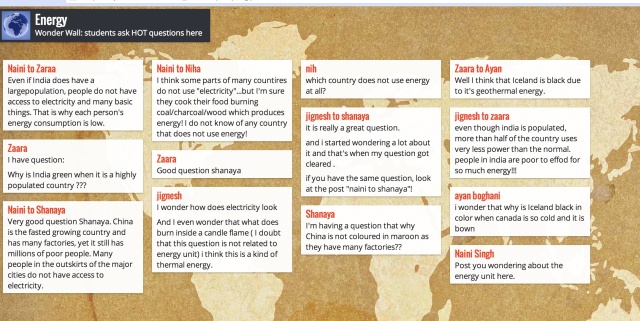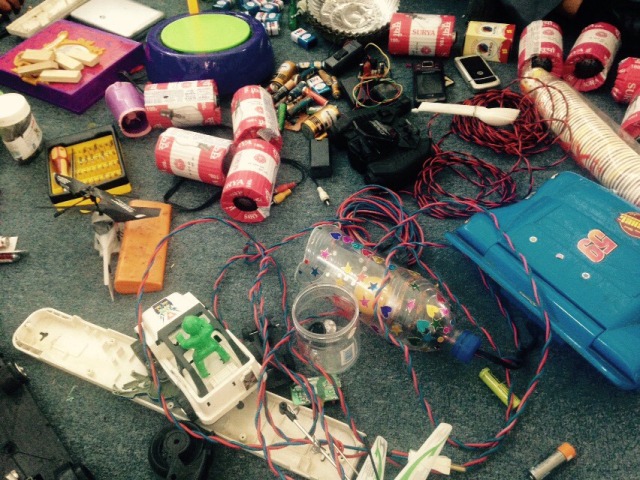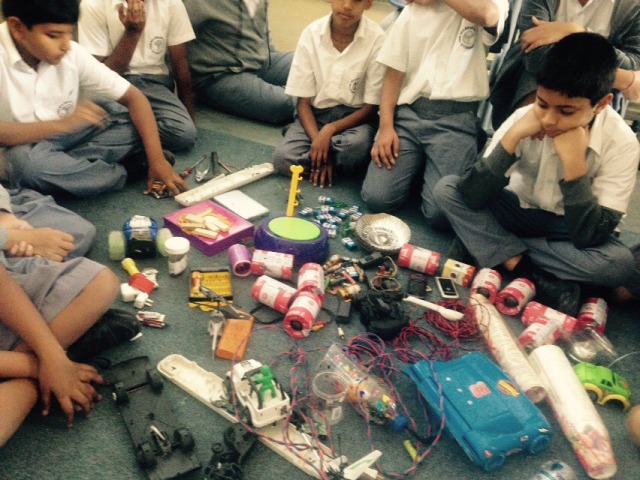Me to students : Does that make sense?
Students to me: (after a while)...not really...
Their understanding of "energy" during the pre-assessment task also reflected a superficial knowledge of the term. And thus our unit of inquiry started. As I was browsing the net, I came across this picture prompt- a map, which I thought would serve as a great provocation. The annual energy consumption per person. Kids love guessing where countries are, so it was a great way to address some geography at this point.

I had also been reading Craig Dwyer's post which inspired me to change my inquiry cycle and use a simpler one. Wonder (while exploring)- Explore (while wondering)- Create (while reflecting)- Reflect (with subsequent wonderings). I was feeling more at ease now. The map allowed the students to make a lot of inferences based on patterns which slowly started emerging during our class discussions. Here is a visual of their wonderings once they went home and revisited the map on their class blog.

Over the weekend, I requested the students to help out with resources. I had no clue what they would come up with, but it had to be something to do with energy. Now the part where I step aside.


At this point, no knows how we are going to sort all this junk into centers.
My students suddenly took charge. The junk would remain where it was. They would pick what they wanted and work with whom the felt like. Here is what happened next...
Soon I would need to step back in and ask them to share their newfound understandings, thoughts and wonderings. Maybe after another day of uninhibited, joyful exploration. How do you feel the unit should go on from here?
Second day: Notice how the students' creations are becoming more sophisticated.
A day later, posted on our class blog...Student action (Inquiry Phase - Create)
Following our tuning-in activity, we are moving into the guided inquiry phase. A class discussion is in progress.
Task: What do the pictures depict: Kinetic or potential energy?
Here, the students were asked to visit a website (in the form of a QR code) and take notes. However, the next day, they didn't seem to have a clear idea about the different types of energy. I put them into groups and asked them to explain the various types of energy to each other. Suddenly, the whole energy level changed. Watch!
Constructivism
I realised how technology was being used seamlessly by the students. Watch how they are using their ipads, androids and other gadgets.
Sorting out the sources of energy:
At this point we stopped and reflected about each source of energy. We then asked as many questions as we could think of in order to clarify our growth in understanding. The sorting out of the questions into various concepts was great fun.
During the short holiday, my students will be researching about renewable sources of energy. My colleague and I have identified a few questions which will help guide them in our absence.
I came across the wonderful website www.thekidsshouldseethis.com which I think is absolutely brilliant. There are some delightful videos on energy. One particular one took the fancy of my students:
solar-powered-classroom
This inspired them to do something for the class too.Their idea is not new of course, yet it provided them with a great opportunity to understand what inquiry in real life meant.
Check out their to-do plan which I have posted on a padlet.
Wait a minute. Why do we need to help our school which is quite well funded? The vision of our school is to create leaders who can give back to our community. What if...
The students are clearly in charge. Their enthusiasm is so infectious. Just by nudging them a bit, I feel I'm on the right track as a facilitator.
At this point, I am not sure we can raise the money. It is quite a lot. But the whole point is for the students to find out how to go about solving a problem.
Class trip to the Green Building, Gachibowli Hyderabad.
A student has posted pictures of the trip on our class
blog: https://fivecomealive.wordpress.com/2015/02/26/green-building/
The students made great connections with their learning as they strolled around the pleasant campus of the green building. A lot of interesting questions came up such as why they structures imbedded in the lawn ( to prevent soil erosion) were hexagonal in shape. They made connections with bee hives and the hexagonal shapes they use in our class.
Students started making connections with their homes and the school. They wanted to know how they could make their homes more green. As they roamed around school and spoke to people, they realised how green their own school was! They identified things such as drip irrigation , recycling of sewage water, and solar panels. They wondered why not all the buildings in our school had solar panels. As they wondered aloud, they came to the realisation that panels were not that cheap and the school probably had a tight budget!
After watching Caine's Arcade (refer above), they were so inspired, they wanted to make a difference. They realised that size did not matter and that they had the power to make a change in the lives of others. Talk about knowledge empowering people!!
So far the children have raised Rs 13,000. Their target is Rs 30,000. Fingers crossed.
With this money, we plan to contact a local supplier of solar panels. They have promised us that they would instal the panels for free at a nearby local school of our choice.
In the mean times, a formative assessment is on. Students have to create a visual persuading the public to think about their carbon footprints and opting for a greener environment.
I will be posting their work on the blog shortly along with this checklist:
At this point, I am not sure we can raise the money. It is quite a lot. But the whole point is for the students to find out how to go about solving a problem.
Class trip to the Green Building, Gachibowli Hyderabad.
A student has posted pictures of the trip on our class
blog: https://fivecomealive.wordpress.com/2015/02/26/green-building/
The students made great connections with their learning as they strolled around the pleasant campus of the green building. A lot of interesting questions came up such as why they structures imbedded in the lawn ( to prevent soil erosion) were hexagonal in shape. They made connections with bee hives and the hexagonal shapes they use in our class.
Students started making connections with their homes and the school. They wanted to know how they could make their homes more green. As they roamed around school and spoke to people, they realised how green their own school was! They identified things such as drip irrigation , recycling of sewage water, and solar panels. They wondered why not all the buildings in our school had solar panels. As they wondered aloud, they came to the realisation that panels were not that cheap and the school probably had a tight budget!
After watching Caine's Arcade (refer above), they were so inspired, they wanted to make a difference. They realised that size did not matter and that they had the power to make a change in the lives of others. Talk about knowledge empowering people!!
So far the children have raised Rs 13,000. Their target is Rs 30,000. Fingers crossed.
With this money, we plan to contact a local supplier of solar panels. They have promised us that they would instal the panels for free at a nearby local school of our choice.
In the mean times, a formative assessment is on. Students have to create a visual persuading the public to think about their carbon footprints and opting for a greener environment.
I will be posting their work on the blog shortly along with this checklist:
Check out the video of the students peer editing. They seemed so engrossed. We spoke of critiquing each other with certain guidelines in mind:
Having a growth mindset.
Defending one's position objectively.
Using the rubric criteria to analyse their work and reflect on their work.
As students poured over various primary and secondary resources, they made a lot of maths connections.
What next?
 |
| http://sonyaterborg.com/tag/reflection/ |
Our unit on energy has ended ...and yet it hasn't. The solar panel project has so far raised Rs 40.000.
I never expected they would manage to raise so much! And then again, they came up with the idea to use Maths week in school, to create a stall where they could make some more money! Their justification? Money and maths go so well together...:)
 |
| Money raised through sheer hard work by the children of grade 5. |
So what lies ahead of us? The reflection sheet they completed revolved around the action component. They have come up with the following actions which need to be taken:
- Buying of the solar panels
- Identifying the school which most needs our help. (If they need it too! ) I will be talking to them about imposing help on others. (I saw a lot of that in Ladhak, when I went to volunteer over there.)
Winding up with our assessments:
Task: Create a visual representation which showcases your understanding of the central idea.
Here is one of my student's work:
Pardon the typo errors below!


























.jpg)
.jpg)
.jpg)


Great wayof inquiry
ReplyDeleteYou've done a great job! I give you a piece of advice, hire a first class specialist from essayhelp24.com, and you'll get more visitors.
ReplyDeleteThis comment has been removed by the author.
ReplyDeleteThis comment has been removed by the author.
ReplyDeleteThis looks like a great inquiry! The students' independence and enthusiasm is marvellous.
ReplyDelete